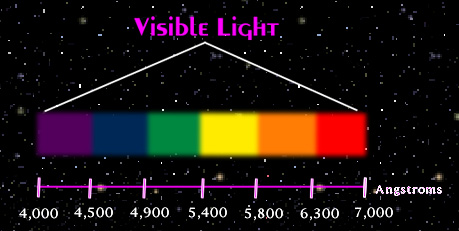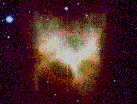
| Light Basics | Types of Light | Light Gallery | The EM Spectrum |
Your Final Objective: Discover the Numerical Wavelength Range for Each Type of Light in This Tour
Use the wavelength tool in the bottom frame to complete this section.
Visible light ranges from about 4,000 angstroms to 7,000 angstroms. In fact, the colors that make up visible light, like red,
blue and green, and
their complements violet, yellow,
and orange, also have their own ranges of wavelength. Take a look at the diagram below to see what these ranges are. Colors next to each other blend together, so the numbers are only approximations of where the spectrum shifts into the next color. Remember, the numbers are telling you how long the wavelength of each type of light is. The light with shorter waves, like violet and blue, are more energetic than the light with longer wavelengths such as red.

![]() Look at the visible light spectrum above. At what wavelength does green merge into yellow? If a star is producing light that is 4,200 angstroms in wavelength, what type of light is coming from this star? As you increase this star's output to
wavelengths that measure 5,000 angstroms, then 6,000 angstroms, at what point(s) does the star's light change colors? Can you make a guess at the wavelength that visible light coming from a "Red Giant" star falls into?
Look at the visible light spectrum above. At what wavelength does green merge into yellow? If a star is producing light that is 4,200 angstroms in wavelength, what type of light is coming from this star? As you increase this star's output to
wavelengths that measure 5,000 angstroms, then 6,000 angstroms, at what point(s) does the star's light change colors? Can you make a guess at the wavelength that visible light coming from a "Red Giant" star falls into?
 |
Red giant stars can lose mass by blowing off material from their outer shells, as in the case of the M giant star HR 3126, shown above, This material condenses as it cools to form dust grains very small in size.
![]() Here are some even trickier questions!
What do you think happens beyond the ends of the visible light spectrum? What type of light besides
blue blends into the violet part of visible light in the electromagnetic spectrum? (hint: it won't be visible light.) Use the tool in the frame at the bottom of the page below to put in your angstrom entry and find out.
Here are some even trickier questions!
What do you think happens beyond the ends of the visible light spectrum? What type of light besides
blue blends into the violet part of visible light in the electromagnetic spectrum? (hint: it won't be visible light.) Use the tool in the frame at the bottom of the page below to put in your angstrom entry and find out.
 |
A neutron star (above) is tremendously dense star toward the end of its life. It's only about 20 km in diameter, yet is has the same mass as a star like the sun! These stars are made entirely of neutrons. A magnetized rotating neutron star emits regular pulses of radiation and is called a pulsar. (No, the word wasn't invented by a car company!)
If a neutron star is producing light that is 200 angstroms in wavelength, what type of light is coming from this star?
A pulsar emits radiation at wavelengths that measure from 200 Å, to 80 Å, to 4 Å and shorter! At what point below 200 Å does the light begin to shift into another type?
What about the other end of the visible light spectrum? What kind(s) of light has wavelengths longer than red light? What if a star produces light that is 7,500 Å in length? What type of light would this star be producing? What else would we, as astronomers want to know about it?
![]() Let's put all this together to map the electromagnetic spectrum. Can you find the numerical boundaries scientists use to distinguish between ALL the light types of the ENTIRE electromagnetic spectrum
(gamma ray, x-ray, extreme ultraviolet, ultraviolet, visible, infrared,
microwaves, and radio waves)?
Let's put all this together to map the electromagnetic spectrum. Can you find the numerical boundaries scientists use to distinguish between ALL the light types of the ENTIRE electromagnetic spectrum
(gamma ray, x-ray, extreme ultraviolet, ultraviolet, visible, infrared,
microwaves, and radio waves)?
Download these forms from your second Internet browser window
to help you organize your investigation.
The Electromagnetic
Spectrum Wavelength Form
helps keep a record of your values (Print it out or make one like it).
Map the Electromagnetic
Spectrum
Helps you write up your final results (Print it out or make one like it)


| Light Basics | Types of Light | Light Gallery | The EM Spectrum |
Copyright © 1996-2001 Regents of the University of California